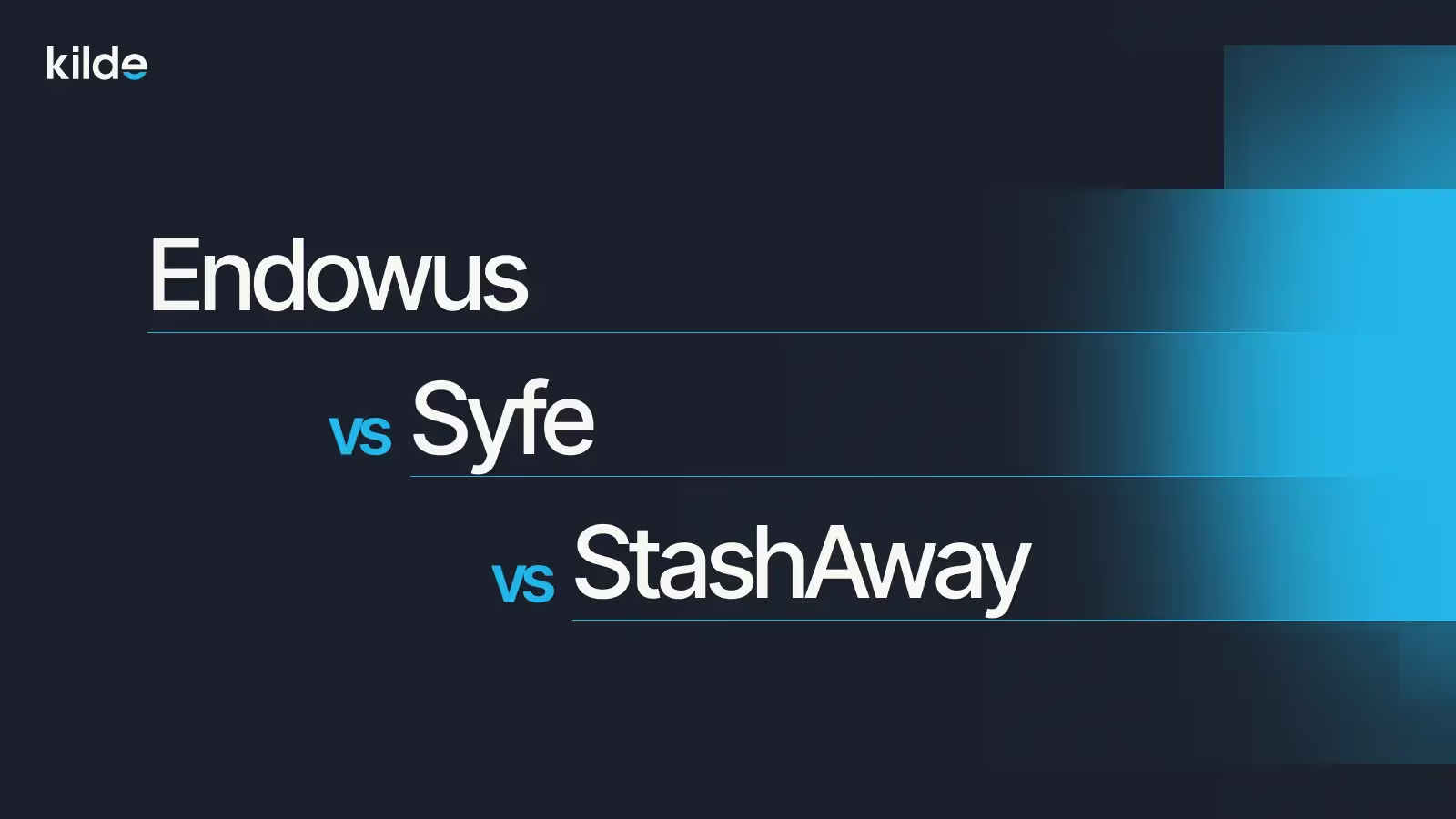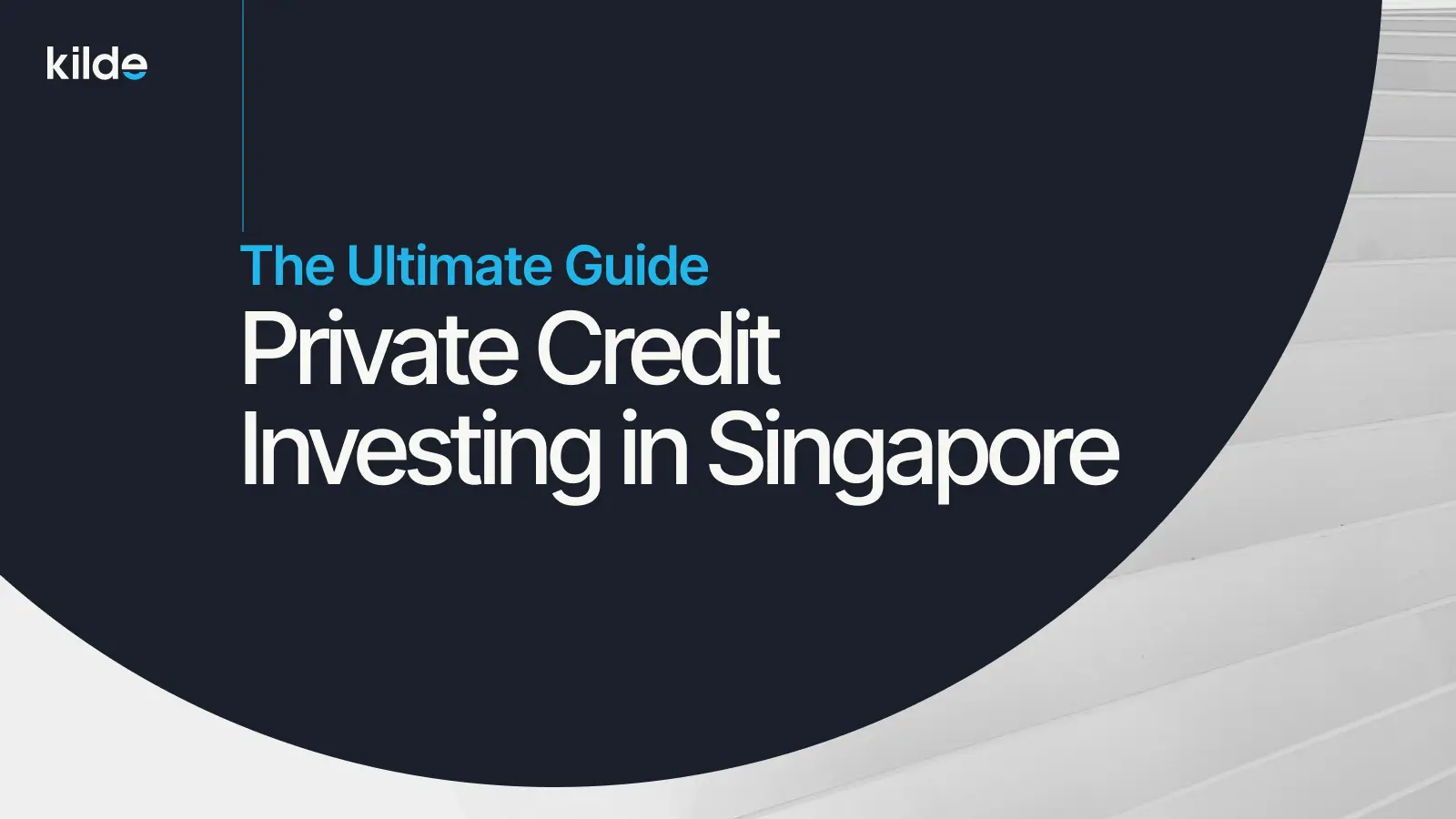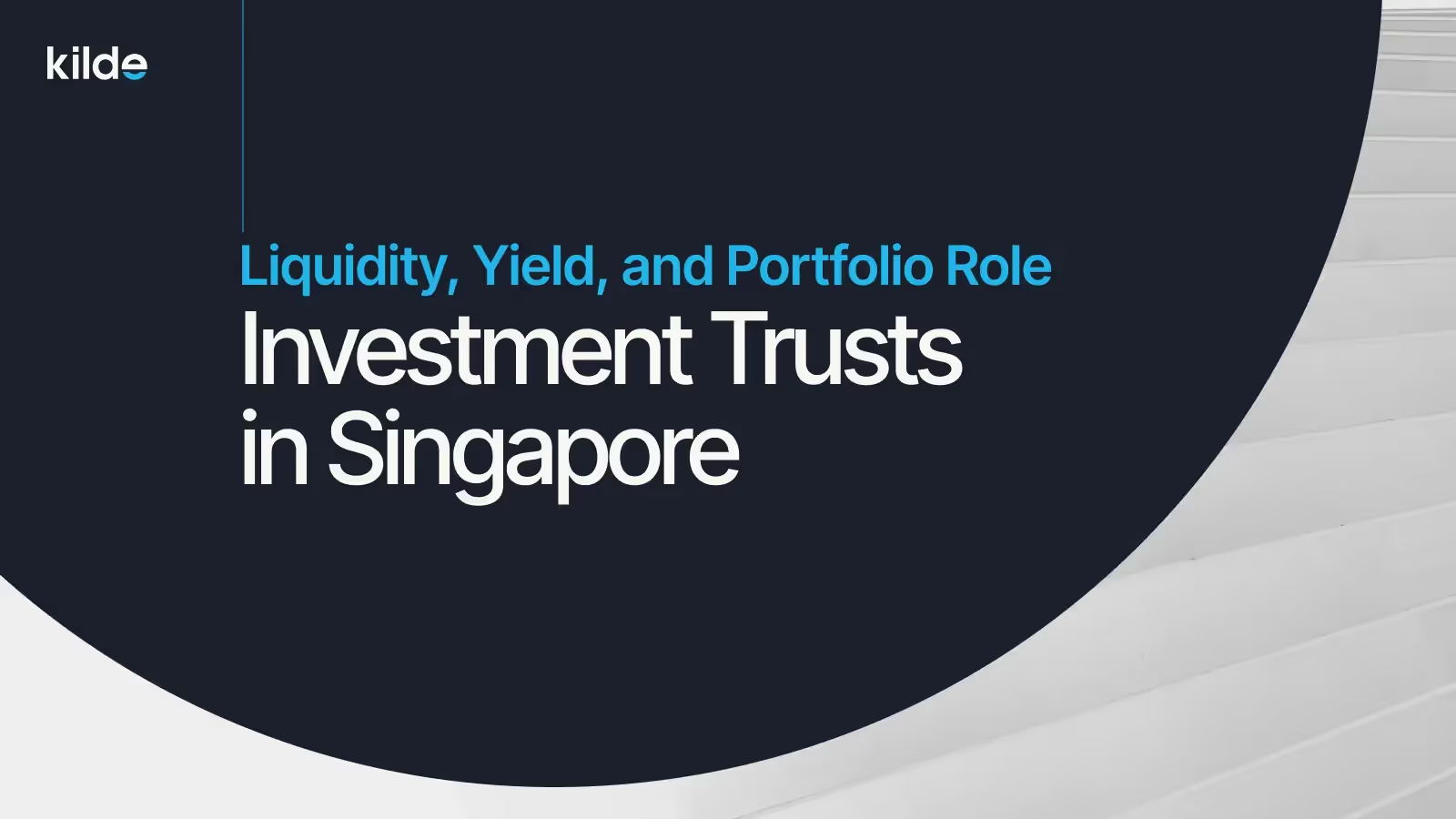Investors seeking private credit income investments in Singapore often compare Kilde and StashAway as two options for generating monthly passive income. This comparison page examines which platform offers higher yields, stronger asset security, more frequent payouts, and overall safer monthly income for investors, especially Singapore’s accredited investors, in 2025.
TL;DR: The Five Biggest Differences
- Yield: Kilde targets ~12% net returns (11–15% p.a.) vs StashAway’s ~4.5% p.a. distribution yield.
- Asset backing: Kilde’s investments are senior-secured private loans backed by 160% + collateral (cash-yielding loan portfolios), whereas StashAway’s portfolio holds diversified investment-grade bonds without specific collateral.
- Payout frequency: Kilde pays investors fixed monthly coupon interest, while StashAway offers flexible monthly distributions (reinvest or withdraw payouts) from bond fund dividends.
- Liquidity: Kilde investments have fixed terms (3–36 months) with limited early exit windows (typically every 3–6 months), whereas StashAway has no lock-in – you can withdraw anytime without fees.
- Regulation & custody: Both are MAS-licensed platforms. Kilde is exclusive to Accredited Investors and holds client funds in a DBS Bank escrow account via a licensed trustee. StashAway is open to retail investors, with client cash in DBS Trust accounts and securities in Saxo custodian accounts.
Comparison Table
{{cta-component}}
Business Model & Underlying Assets
Kilde
- Platform Type:
- Private credit investment platform.
- How It Works:
- Sources high-yield private loans.
- Structures these into bond-like debentures for investors to fund.
- Investor Role:
- Accredited investors provide capital.
- Investors become bondholders, earning fixed interest coupons.
- Borrower Role:
- Non-bank lenders and fintech financing companies receive funding.
- They use the capital to issue consumer or SME loans.
- Collateral:
- Borrower’s loan receivables back each deal, adding a layer of security.
- Investment Characteristics:
- Private debt investments (non-traded, held to maturity of usually 1–3 years).
- Receive contractual interest payments during the term.
- Investment Focus:
- Alternative investments uncorrelated with public markets.
- Offers mid-teen yields through carefully managed credit risk.
StashAway
- Platform Type:
- Robo-advisor style Income Portfolio.
- How It Works:
- Offers a managed bond fund portfolio for mass-market investors.
- Branded as “Income Investing powered by J.P. Morgan Asset Management.”
- Investor Role:
- Client money is invested in a basket of bond funds and ETFs selected for reliable income.
- Underlying Assets:
- Globally diversified fixed-income securities.
- Primarily investment-grade bonds (corporate and government).
- Includes some high-yield and other fixed income sectors for additional yield.
- Diversification & Liquidity:
- Funds pooled to purchase units of professionally managed funds.
- Exposure to hundreds of bonds across issuers and geographies via liquid securities.
- Portfolio Management:
- Constructed with JPMorgan’s guidance to balance yield and risk.
- Automatically rebalanced over time.
- Investment Focus:
- Aims for steady income generation.
- No direct lending – money is conservatively managed in public bond markets.
Income Predictability vs Volatility
Kilde
- Income Stability:
- Provides a stable stream of interest, similar to a fixed deposit or bond coupon.
- Each deal specifies a fixed annual interest rate (e.g., 12% p.a.), ensuring investors know exactly how much they will earn monthly.
Example: $100,000 invested at 12% p.a. yields approximately $1,000 monthly in coupon payouts.
- Key Features:
- Contractually fixed payments – income does not fluctuate unless a borrower defaults (which has not occurred to date).
- No sensitivity to daily market price changes or interest rate swings.
- Ideal For:
- Investors seeking predictable and reliable monthly cash flow.
- Those wanting to cover monthly expenses from investment income.
- Payment Frequency:
- The majority of deals pay monthly coupons.
- Some deals may offer quarterly payments, though the platform emphasises monthly options.
StashAway
- Income Stability:
- It aims for consistent income but comes with some volatility due to its bond fund structure.
- Distribution Yield:
- Approximately 4.5% p.a. (not a guaranteed fixed rate).
- Can change with interest rate conditions and fund performance.
- Income Flow:
- Underlying bond funds typically pay monthly dividends.
- StashAway passes these payouts to investors who opt for income.
- Performance Notes:
- Historical income around 4–5% annually, but yield may adjust if rates rise or fall significantly.
- Account value (NAV) fluctuates daily with market movements.
- Bond prices may drop if interest rates climb or credit spreads widen, leading to potential temporary losses.
- Volatility Profile:
- StashAway estimates a 3–7% expected volatility range on this “Conservative” portfolio.
- In 2024, the portfolio saw a few modest down months in NAV, though overall returns remained positive.
- Ideal For:
- Investors comfortable with slight income variability and NAV fluctuations in exchange for full liquidity.
{{cta-component}}
Risk Management & Collateral Controls
Kilde
- Credit Risk Management:
- Approves only ~9% of borrower applications after thorough due diligence.
- Deals are structured as senior-secured loans, giving investors first claim on borrower assets in case of default.
- Collateral Requirements:
- Loans are over-collateralised, typically at ~160% coverage.
- Example: A borrower taking $1M must pledge ~$1.6M in loan receivables/assets.
- Provides a cushion — if the borrower fails to pay, Kilde can seize and liquidate collateral to recover funds.
- Loans are over-collateralised, typically at ~160% coverage.
- Monitoring & Enforcement:
- Quarterly monitoring of borrower loan portfolio performance and covenant compliance.
- Legal mechanisms allow Kilde to:
- Take control of the borrower’s loan book.
- Collect repayments or sell assets to make investors whole.
- Performance History:
- There is a 0% default rate to date — all interest and principal are paid as expected.
- Even in the event of a default, Kilde has structured layers of protection:
Stringent screening
Excess collateral
Short loan tenures
Escrowed funds
- Key Risk Consideration:
- If collateral fails to generate sufficient cash, investors could face losses.
- However, Kilde’s multi-layered approach aims to mitigate this risk significantly.
StashAway
- Risk Management Approach:
- Focuses on diversification and asset quality rather than collateral.
- Portfolio Composition:
- Primarily holds investment-grade bonds (corporate/government).
- Default risk on any single bond is very low.
- No specific collateral — bonds are unsecured debt of issuers.
- Diversification Strategies:
- Exposure spread across many issuers and bond types globally.
- Caps any single fund at 30% of the portfolio to avoid overconcentration.
- The investment team actively monitors and reoptimises the portfolio.
- Portfolio Adjustments:
- Example: Shifted away from US aggregate bonds to emerging market debt when advantageous.
- Additional Risk Controls:
- Interest rate risk: Managed with moderate duration and short-duration bonds to reduce sensitivity.
- Currency risk: Fully hedged to SGD, eliminating exposure to USD fluctuations — unlike Kilde, where deals may be in USD or EUR (potential FX risk).
- Regulatory & Management Oversight:
- Portfolio is built under the conservative guidance of J.P. Morgan Asset Management.
- Regulated by MAS (Monetary Authority of Singapore).
- No leverage used.
- Key Risk Consideration:
- No collateral or guarantees.
- Default events are rare, and diversification limits impact on the overall portfolio.
- Overall, designed to maintain a low risk of permanent loss.
Regulatory Oversight & Custody
Regulatory Oversight
Kilde
- Holds a Monetary Authority of Singapore (MAS) Capital Markets Services (CMS) licence (Licence No. CMS101016) to deal in securities.
- Operates as a regulated financial institution in Singapore, complying with:
- Capital requirements.
- Compliance standards.
- Reporting obligations.
- Offerings are made under exemptions limited to Accredited Investors (AIs).
- Investors must meet statutory net worth or income thresholds.
- Not open to retail investors.
- Typical for private capital market products.
- Regulatory intent: higher-risk, high-return products are reserved for sophisticated investors.
- MAS oversight assures legitimacy and conduct, but private offerings have less disclosure than public retail funds.
StashAway
- Holds an MAS licence (CMS100604), operating as a fund management platform (robo-advisor).
- Open to all investors, including retail — no accredited status required.
- One of Singapore’s major regulated digital advisory firms.
- Must adhere to MAS rules on:
- Client asset segregation.
- Disclosures.
- Suitability assessments.
- Income Portfolio is a managed unit trust portfolio (sold by a licensed entity with MAS supervision).
Custody of Client Assets
Kilde
Uses a segregated client escrow account at DBS Bank, administered by independent trustee Perpetual Asia Limited.
Process:
- Investor funds go into DBS escrow account.
- Kilde cannot access funds freely.
- Trustee verifies transactions; funds released only to:
- Fund specific investments.
- Return to investors per instructions.
- Interest payments flow into escrow before distribution to investors.
Key Protection
If Kilde fails, investor funds are:
- Safely held in trust at DBS.
- Not commingled with Kilde’s assets.
- Investors retain legal rights independent of Kilde’s corporate entity.
StashAway
Leverages third-party custodians:
- Cash held in DBS Bank trust account.
- Securities are held in custody by Saxo Capital Markets (a MAS-regulated broker/custodian).
Structure:
- ETFs or unit trusts owned via StashAway are kept in:
- Segregated account under investor’s name.
- Or a StashAway nominee structure at Saxo.
Key Protection
If StashAway fails, assets:
- Remain with the custodian.
- Can be transferred or liquidated under trustee or liquidator oversight.
- Are not part of StashAway’s corporate creditors.
Summary
Both Kilde and StashAway ensure that:
- Investments are segregated from the platform’s own finances.
- Custodial arrangements minimise risk.
- Even in the event of platform bankruptcy, investor holdings are protected and not wiped out.
{{cta-component}}
Fees & Net-of-Fee Return
Kilde
- Platform Fee:
- Charges 0.5% per annum on the principal invested.
- Deducted from interest payments (prorated across each payout).
Example: Deal pays 12% gross → after 0.5% fee → 11.5% net yield (before taxes).
- Fee Characteristics:
- Flat fee structure.
- No additional charges:
No entry fee.
No exit fee.
No upfront load.
Early exit window (if available) may involve a slight discount but no penalty fee.
- Effective Split:
- ~96% of gross interest goes to investors.
- ~4% goes to Kilde — considered reasonable given the high gross yields.
StashAway
- Management Fee:
- Tiered annual fee:
Ranges from 0.8% to 0.2% (for large balances).
Typical investors: 0.6–0.8% p.a. on capital.
- Tiered annual fee:
- Underlying Fund Costs:
- Portfolio’s bond funds have expense ratios (~0.4% p.a.).
- StashAway rebates 100% of trailer fees.
- The quoted ~4.5% yield is after fund fees but before StashAway’s management fee.
- Net Yield After Fees:
- Example calculations:
4.5% gross → minus 0.8% fee → ~3.7% net.
4.5% gross → minus 0.3% fee (large portfolio) → ~4.2% net.
- Example calculations:
- Fee Features:
- No other charges:
No entry or exit fees.
Unlimited free withdrawals and deposits. - Occasionally offers promotions (e.g., fee waivers, SRS deposit bonuses) that can temporarily improve net returns.
- No other charges:
- Typical Net Cost to Bake In:
- Around 0.5–0.8% management cost when estimating take-home yield.
Summary
Bottom Line: Kilde’s high gross returns comfortably absorb its small fee, delivering double-digit net yields. StashAway’s lower gross yield is more impacted by management fees, but it offers diversification and liquidity aligned with industry norms.
Liquidity & Early Exit Mechanics
StashAway
Liquidity Level:
Highly liquid – no lock-ups or maturity dates.
Accessing Funds:
Top up or withdraw anytime via the app.
Typically takes 2–3 business days to receive money (including accrued gains) in your bank account.
Why So Flexible:
Underlying assets are traded bond funds and ETFs, which can be readily sold on the market.
Fees or Penalties:
None for withdrawing funds.
Important Consideration:
Withdrawals during down markets may result in losses, but you are never locked in for years.
Analogy:
Behaves like a mutual fund or unit trust — offers daily liquidity at NAV.
Kilde
Liquidity Level:
Low liquidity by design; funds are effectively locked into fixed-term bonds.
Investment Tenures:
Typically 3 to 36 months (most commonly 1–2 years).
Payout Structure:
Interest paid during the term, principal repaid at maturity.
Early Exit Options:
Many deals include negotiated early exit windows:
- Example: A 24-month debenture might allow redemption at 6, 12, or 18 months.
- Could offer quarterly liquidity, single halfway points, or be fully locked.
Details vary by deal — check “early withdrawal schedule” on each deal’s info page.
Conditions on Early Exit:
Usually, you:
- Get back principal.
- Forfeit future interest.
- Face no penalty (in many cases).
There may be:
- A cap on how much can be redeemed per window.
- A queue system is used if demand to exit is high.
Secondary Market:
None – no marketplace to freely sell Kilde investments on demand.
Best Use Case:
Suitable for funds you can afford to lock in and plan around liquidity windows.
Summary
Bottom Line: Kilde offers much higher yields but sacrifices liquidity. StashAway offers instant access and flexibility, ideal for managing short-term or unpredictable cash needs.
{{cta-component}}
Ideal Investor Profile
Kilde
- Target Audience:
Singapore Accredited Investors seeking higher-yield income investments.
- Ideal Characteristics:
Investors with:
- A stable core portfolio looking to allocate a portion to alternatives.
- Desire for double-digit returns (~11–15%).
Comfort with:
- More complexity (evaluating individual deals).
- Longer commitment periods.
- Asset-backed security.
- Investor Preferences:
- Contractual, collateralised investments over volatile stocks or REITs.
- Monthly cash flow to fund lifestyle or retirement.
- Requirements:
- Must be an accredited investor by law (implying higher risk tolerance and financial sophistication).
- Suggested minimum ticket: ~$10,000.
- Summary Fit:
Best for yield-seeking, financially savvy investors who:
- Want MAS-regulated, private debt deals.
- Can handle illiquidity and credit risk in exchange for higher income.
StashAway
- Target Audience:
Conservative or hands-off investors seeking moderate yield (~4% net) with simplicity and liquidity.
- Ideal Characteristics:
Suitable for:
- Working professionals or retirees in Singapore.
- Investors wanting better returns than bank deposits or CPF.
- Those unable or unwilling to take on the risk of equities or exotic products.
- Investor Preferences:
- Liquidity and flexibility (funds available for emergencies or major expenses).
- Capital preservation over high returns.
- Low-risk, conservative portfolios as part of a bond/fixed-income allocation.
- Ease of use — no need to select individual deals or monitor loans.
- Requirements:
- No accreditation needed.
- No large minimum investment — start with even $100 and add monthly.
- Summary Fit:
Best for mass-market investors wanting:
- An easy, flexible monthly income solution.
- MAS-licensed oversight.
- A core income fund holding in their portfolio.
Combined Use Case
For Savvy Investors: Many accredited investors may use both platforms:
- StashAway income → for liquidity, stability, and conservative income.
- Kilde → to boost overall portfolio yield with private credit deals.
Benefit — combines the best of both worlds:
- Liquidity and simplicity (StashAway).
- High-yield, alternative income (Kilde).
Why Singaporean Accredited Investors Choose Kilde
Unique Proposition for Accredited Investors
For Singaporean Accredited Investors (AIs), Kilde offers a distinctive opportunity in the income investment landscape. Focused on capital preservation paired with high yield, Kilde’s private credit deals are structured to deliver superior returns without exposure to volatile market swings.
Key Reasons AIs Prefer Kilde
- 11–15% Target Yield
- Achieve substantially higher monthly income compared to traditional portfolios.
- Deals historically average around 12% net returns, giving accredited investors a robust tool to:
Beat inflation.
Grow passive income meaningfully.
- DBS Escrow Account
- Funds are securely held in a DBS Bank escrow account, managed by an independent trustee.
- This bank-grade custody arrangement ensures:
Your money never commingles with Kilde’s corporate funds.
Continuous protection of investor capital.
- 0% Default Track Record
- Kilde has maintained a zero-default record since inception.
- Achieved through:
Rigorous due diligence.
Senior-secured collateral backing every deal. - Provides investors with confidence that:
Principal is safeguarded.
Downside scenarios are mitigated.
Summary
Kilde empowers accredited investors to access higher, safer monthly income through carefully curated private-credit bonds.
It combines:
- The upside of alternative investments.
- Strong risk mitigation via:
- MAS regulation.
- Collateralised structures.
- Trustee and escrow safeguards.
For those who qualify as AIs, Kilde can be a game-changer for income strategies.














